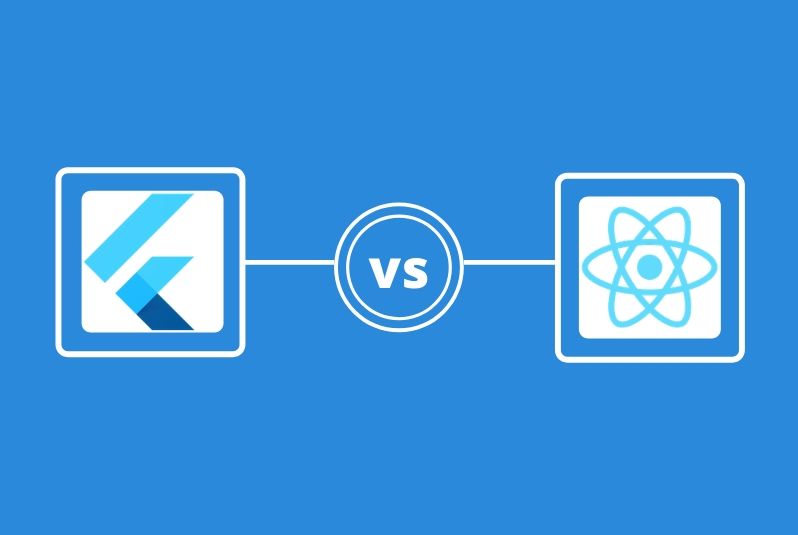With more than 5.16 billion (68% of the world population) unique mobile users in the world and with the proliferation in this number every year, there is no surprise why we are witnessing an influx in the use of mobile-based applications by businesses from all around the globe. There are currently more than 5.6 million mobile-based applications available for download and in such a crowded market, you will surely need to stand out.
In order to make your mobile-based application stand out, you will have to choose the right software development framework. And when you will begin your hunt for the best mobiles based software development framework, you will find yourself confused between Flutter and React Native.
Currently, both React Native and Flutter have become a go-to choice when it comes to developing a cross-platform mobile app. If you are completely new to the world of mobile app development, then soon, you will find yourself to be a part of the on-going React Native vs Flutter debate.
So, to make things easy for you, we will discuss the features, advantages, and disadvantages of both the platforms; so that you can decide which one is better for you.
What is Flutter?
Flutter is a UI toolkit from Google that is used for making enticing, engaging, and responsive mobile apps from a single codebase. It was released in May 2017 and since then it has become one of the most popular choices among mobile app developers. The first version of Flutter was named Sky and it was used on the Android platform.
What is React Native?
This open-source mobile application framework has been developed by Facebook and it was released in March 2015. This highly popular mobile app development framework can be used for developing apps for both IOS and Android. The seamless cross-platform and native development for everyone make this framework stand out of the crowd.
Comparison of both the frameworks on different parameters
Programming language
Flutter relies on dart language and this language is reactive which means that it eliminates the issue of responding to incoming asynchronous data. If you already have worked with JAVA and C++ then using flutter will become a cakewalk for you. It also supports the unique Hot Reload feature through which the mobile application can be easily rerun and this boosts the speed of Flutter app development. The official supporters of Flutter are Android Studio, Visual Studio Code, and IntelliJ.
While on the other side, React Native development relies on React Library and it uses JavaScript. Since the data flow is unidirectional, the components become stateless by managing each and every type of incoming data from a single point. The JavaScript framework can also be used for a single code base for both IOS and Android.
Architecture
Since it has been only 2 years since the release of Flutter, many programmers find it to be very confusing, and sometimes, they hesitate in choosing it as their go-to framework. There are more than 1450 packages available in Flutter and that might work in favour of this robust framework. The Business Logic Component or BLoC is the basic architecture of Flutter. It relies on the Dart framework that uses the Skia C++ engine and this is why most of its components are in-built.
The React Native might be an older player in the industry but since it relies on JavaScript, it needs a bridge for proper communication with its native module. The main architecture of React Native development is Flux and you should know that it is the most preferred architecture by programmers as it keeps the code predictable when compared to other frameworks.
IDE and Ease of coding
One of the biggest advantages of React Native comes in the form of IDEs as it is supported by all the popular IDEs like Nuclide, Atom., VIM, and much more. This makes it easy for programmers to work with React Native without worrying about IDE support.
But in the case of Flutter, the only supported IDEs are Visual Studio Code and Android Studio. It is clearly visible that Flutter has less support than React Native and that might act as a drawback for programmers using Flutter.
The learning curve in the case of React Native is easier since it relies on JavaScript but since Dart is completely new for many programmers, working on Flutter can prove to be a little bit difficult during Flutter app development.
Flexibility and Stability
Stability is surely one of the most important features of any framework. It’s true that both React Native development and Flutter app development has support from leading tech communities, and that’s why they both are highly stable.
But since React Native has a much larger community in comparison to Flutter, it enjoys a slight advantage over the Facebook powered mobile app development framework. We can say that at this stage, React Native is a little bit ahead of Flutter in terms of stability.
When it comes to flexibility, then React Native is a clear winner because it offers an unparalleled user experience by directly interacting with the native platforms. While on the other side, Flutter is thriving on customized widgets that are available in the beta stage for enhancing the user experience.
After going through this article, you must have got a fair level of an idea about both the popular mobile app development frameworks and this will help you in deciding the best one out of these two. In order to make a better decision, you will have to first focus on what you want from your mobile app instead of directly getting into the details of React Native and Flutter app development.
It’s true that React Native has now become a veteran app for most of the programmers but even Flutter is leaving its mark and it is surely going to stay in the mobile app development work for long.
Subscribe to Saffron Tech
Explore your marketing zen with our newsletter! Subscribe now.




